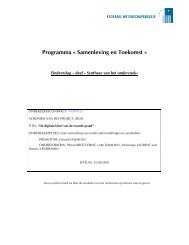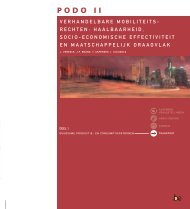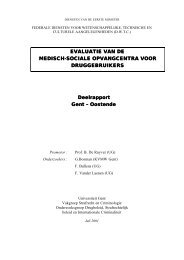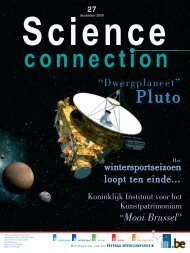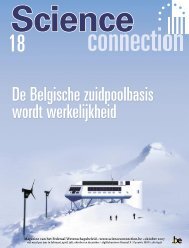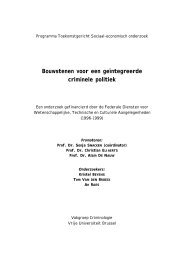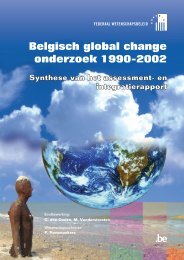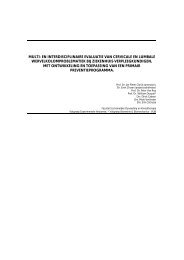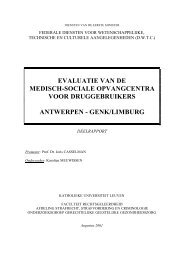chapter 3 inventory of local food systems
chapter 3 inventory of local food systems
chapter 3 inventory of local food systems
You also want an ePaper? Increase the reach of your titles
YUMPU automatically turns print PDFs into web optimized ePapers that Google loves.
Project CP/59 - “Instruments and institutions to develop <strong>local</strong> <strong>food</strong> <strong>systems</strong>”<br />
Transport efficiency <strong>of</strong> transport modes for import from abroad<br />
Another large factor in the total energy and emission bill <strong>of</strong> <strong>food</strong> products is the<br />
transport efficiency <strong>of</strong> import from abroad. Import occurs when domestic products are<br />
not available or products are not homegrown at all, e.g. tropical fruits. But also inseason<br />
there are a lot <strong>of</strong> <strong>food</strong> products imported that can also be homegrown. Table 5<br />
shows the calculated levels <strong>of</strong> energy uses and carbon dioxide emissions for the most<br />
used transport modes over longer distances. For each transport mode the average load<br />
capacity (ALC) is given. Two parameters play the most important role: (1) the traveled<br />
distances: 400 km or import from neighbouring countries, 1500 km or continental<br />
transport and 6000 km or intercontinental transport, and (2) the transport mode used:<br />
transport by truck, by vessel, by train or by aircraft.<br />
Combining these two, for short distances (400 km) bulk transport by vessel seems to be<br />
the most sustainable on energy and emission basis (0.41 MJ/kg and 29.77 g CO2/kg),<br />
although a lot <strong>of</strong> <strong>food</strong> products are difficult to transport in bulk. All other transportation<br />
modes are two to three times more energy consuming or emit two to three times more<br />
greenhouse gasses. The highest value is for non-bulk transport by inland vessel (1.08<br />
MJ/kg and 79.72 g CO2/kg). For continental transport (1500 km) sea vessels use less<br />
energy (0.69 MJ/kg) and emit less CO2 than trucks, electric trains and freight aircrafts<br />
(respectively 2.80, 3.88 and 29.43 MJ/kg). Transport by aircraft results in CO2 emissions<br />
that are more than 40 times those <strong>of</strong> trucks. Intercontinental transport results in even<br />
higher energy consumption and CO2 emission with 2.75 MJ/kg for sea vessels and<br />
103.33 MJ/kg for freight aircrafts.<br />
These calculations are based on averages from literature, so there can be quite large<br />
differences when taking into account real loading factors, productive rides, flights in<br />
different stages, etc. It also has to be stressed that transport to and from loading points<br />
are not included in this study.<br />
Production in heated greenhouses versus in open air<br />
Differences in energy use for production in greenhouses versus in open air can also<br />
make a large variation in total energy consumption. Assuming that most energy is<br />
consumed by the heating installations <strong>of</strong> these greenhouses, we only take into account<br />
the energy used for this heating, excluding electricity consumption for e.g. lighting. Of<br />
the <strong>food</strong> items considered in this study only tomatoes and cabbage lettuce are produced<br />
both in greenhouses and in open air in Flanders. Based on Maertens and Van Lierde<br />
(2003) and Georges et al. (2003) we calculated that the heating <strong>of</strong> greenhouses uses on<br />
average 26.73 MJ/kg tomatoes and 22.90 MJ/kg cabbage lettuce or 1459.41 g CO2/kg<br />
tomatoes and 1250.21 g CO2/kg cabbage lettuce. This means that respectively for LFS<br />
and MFS for the heating <strong>of</strong> greenhouses in Flanders, 10 and 18 times more energy is<br />
consumed for tomatoes and 9 and 21 times for cabbage lettuce than for non heated<br />
production in open air. These figures are yearly averages meaning that for production in<br />
winter/<strong>of</strong>f season these ratios are a lot higher and for production in summer/full season<br />
these ratios are close to zero.<br />
SPSD II - Part I - Sustainable production and consumption patterns - Agro-Food 45



